
|
January 15th 2003
Driving the Italian Formula Juniors Part I
by Ed McDonough
Photos by Peter Collins
Correspondent Ed McDonough tests three Italian Formula Juniors at
at Silverstone. Part I details the OSCA, Part II will compare
the Stanguellini and Autosud.
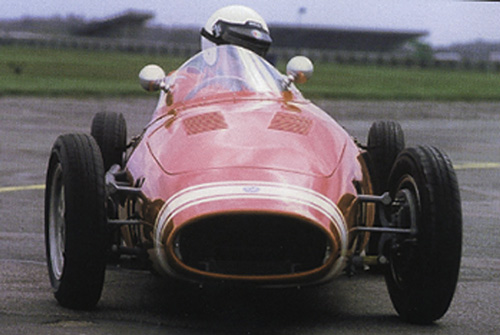
McDonough wrings out the OSCA Formula Junior at Silverstone.
|
Formula Junior-A Training Ground
In my youth, during the period in which I first encountered motor racing, the 500cc Formula 3 had been the �entry� route to serious single seat racing for some years in Europe but was by that time on its last legs. In the USA, there was less emphasis on single seaters but by the early �60s, Formula Junior had caught on, and I have always seen it as an essential part of my history. I particularly was smitten by the front engine cars from Italy.
Formula Junior was very much as it sounds, a "junior" category created by the Italian driver and race administrator Count Giovanni Lurani, who saw it as primarily an Italian formula to provide a single seater training ground for Italian drivers. The category started in Italy in 1958 but rapidly caught on across Europe and the US, and lasted for six years.
The early cars were built to regulations based on the Italian National 750 Formula Corse. The fundamental elements of the cars had to derive from recognised touring cars of which 1000 units had to have been built in the previous 12 months. The FIA rules set a minimum wheelbase of 6� 7 �", maximum track of 3� 7 5/16", with maximum body width of 3� 1 �" and a minimum weight of 400 kgs. Lower weight was allowed for cars with engines under 1000cc.
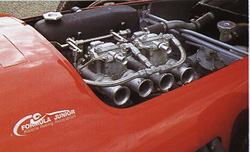
The heavy but reliable Fiat 1100 provided the power for most of the first Italian Juniors.
|
The original Formula Junior FIA regulations specified that the cylinder block including the head and the cylinders if they were removable had to be from an engine found in a car which the FIA classified as a touring car. As the category was born in Italy, virtually all the early engines came from the Fiat 1100, which used a 4 cylinder 1089cc unit which could take twin side draft Weber 40DCO carburetors. Certainly the Stanguellini, OSCA and Autosud used this engine, as did Volpini and Bandini, though the Taraschi, Dagrada and some of the lesser Italian marques employed the Lancia V-4 unit. As the British market developed, the BMC Series 4 998cc engine with single Weber was popular, and this increased to 1098cc, but as the motor moved to the rear, the 997cc Ford 105E developed by Cosworth was a faster alternative. Then came the Holbay and Cosworth versions of the 1098cc 105E which was to prove dominant.
Roberto Lippi won the 1958 Italian championship in a Stanguellini-Fiat, Raffaele Cammarota took it in 1959, and then in 1960 Formula Junior really took off when the British went rear-engined and Henry Taylor won the Monaco Junior race in Ken Tyrrell�s Cooper T-52. From that point on the front engine cars were dead in international competition. It is therefore fortunate that so many survived to enjoy the current enthusiasm for both front and rear engine juniors in historic racing in the USA and Europe. It is even more exciting that they now have their own races again.
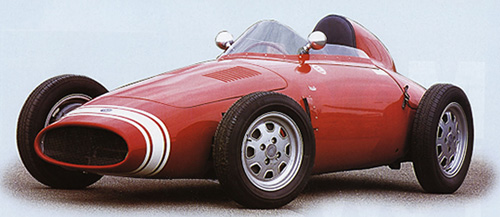
Handsdown winner in the looks department, the OSCA was even more attractive than
the Stanguellini. A miniature Maserati 250F, sans the performance.
|
The Test Cars
There were F.Jr. manufacturers springing out of the woodwork from A to Z, well A to Y actually��Alexis to Yimkin. The front engine cars included the Alexis, Autosud, Bandini, BMC, Bond, Condor, Dagrada, Deep-Sanderson, Elfin, ETA, Elva, Gemini, Hillwood, Lola, Moorland, OSCA, Stanguellini, Terrier, U2, Volpini, Yimkin��and these are just a few. Many manufacturers produced either front or rear engine models or both.
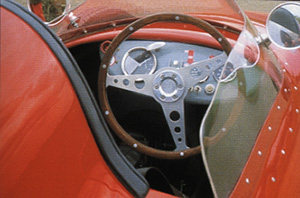
Inviting cockpit of the OSCA, "tucked down in and part of the car".
|
The cars you see here were inspired by the announcement of the new formula in Italy and followed the standard approach, for the most part, to designing the new cars.
In this kind of comparative test, the usual format is to lay out all the similarities and differences, outline the pros and cons, and then hedge very carefully about the �best� or the �favourite�. For me, it was going to be OSCA or the Stanguellini, judged solely on their good looks and resemblance to the Italian Grand Prix cars of the period. With that problem out of the way, I could get down to learning some history and driving some wonderful old cars.
The OSCA
Crispian Besley has become quite serious about his Formula Junior racing over the last year and has put a great deal of work and driving time into both of his cars, the OSCA and an Elva Formula Junior that he owns as well.
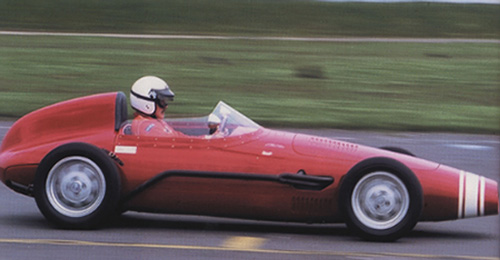
The graceful, classic body was built by Morelli. After 1956, Morelli was responsible for the majority of OSCA bodies.
|
The OSCA is chassis number 008, which puts it in the middle of the 16 F.Jr. cars built and is one of several which found their way to the USA in 1960. Featuring the beautiful bodywork by the Morelli brothers, this car was purchased by a Mr. Williams in Italy who shipped it to the States. Some stories connect it with Luigi Chinetti and the North American Racing Team who ran OSCAs for several drivers including the Rodriguez brothers. It is possible this car was run by Denise McCluggage at Sebring in 1960. Chassis 008 and 009 stayed together for some time, passing to Jim Profit and then to Barry Williams in 1983, to William Perrone in 1989, Eric Traber in 1997 and into a Swiss museum until Irvine Laidlaw bought 008 and the chassis of 009 in 2000. Crispian Besley purchased 008 late in 2000.
The OSCA has incredible presence, the OSCA Fratelli Maserati Bologna badge declaring its heritage on the nose, which slopes upwards and back in classic Fifties style. Like the Stanguellini, once you are in, you are tucked down and are part of the car. The grip is provided by Firestone F5-60 45R x 14 and 15s on the rear, mounted on lovely Amadori of Bologna cast wheels--these are only 3 �" rims!
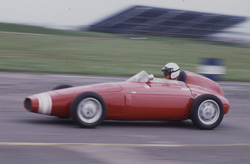
In 1960, Colin Davis achieved victories at Salerno, Monza and Syracuse with the OOSCA. McDonough is relishing is time behind the wheel.
|
The OSCA, with its relatively thick chassis tubes, tends to wrap around the driver, providing a snug fit around the shoulders with the tops of the side screen virtually in contact with your shoulders. The layout is very compact and like the Stanguellini, you feel to be an intrinsic part of the car. I found myself sitting a little higher than I expected, given the way one�s body has disappeared into the nether-regions. You make a choice about looking over or attempting to peer through this screen whose curves make vision a bit difficult. Rearward vision through the mirrors is fine. The dominant impression behind the three spoke wheel is how the bodywork comes up to meet the driver, and hence you feel somewhat more protected than in the Autosud, though this may be more illusion than reality. The transmission runs down the side of the left leg and the gearshift is to the left. The rev counter shows 6500 usable revs, there are water and oil pressure and temperature gauges, and a pull out bonnet release lever near the screen.
I have to say that I loved driving the car, though attention needs to be kept on the revs, mainly holding them at workable level. In spite of my trouble getting the clutch engaged, once moving everything about the car is highly sensual, that ripping noise from the exhaust bringing back the early '60s in a moment. The OSCA seems happier at higher speeds, in long sweeps, especially on those narrow tires. A bit of slide is totally acceptable, even in top at 100 mph. This is truly a Maserati 250F gone a bit smaller! It starts with over steer and change to under steer. This is more pronounced on the OSCA and the brakes aren�t very firm.
Next, Ed climbs into the Stanguellini and Autosud, so stay tuned!
|

|



